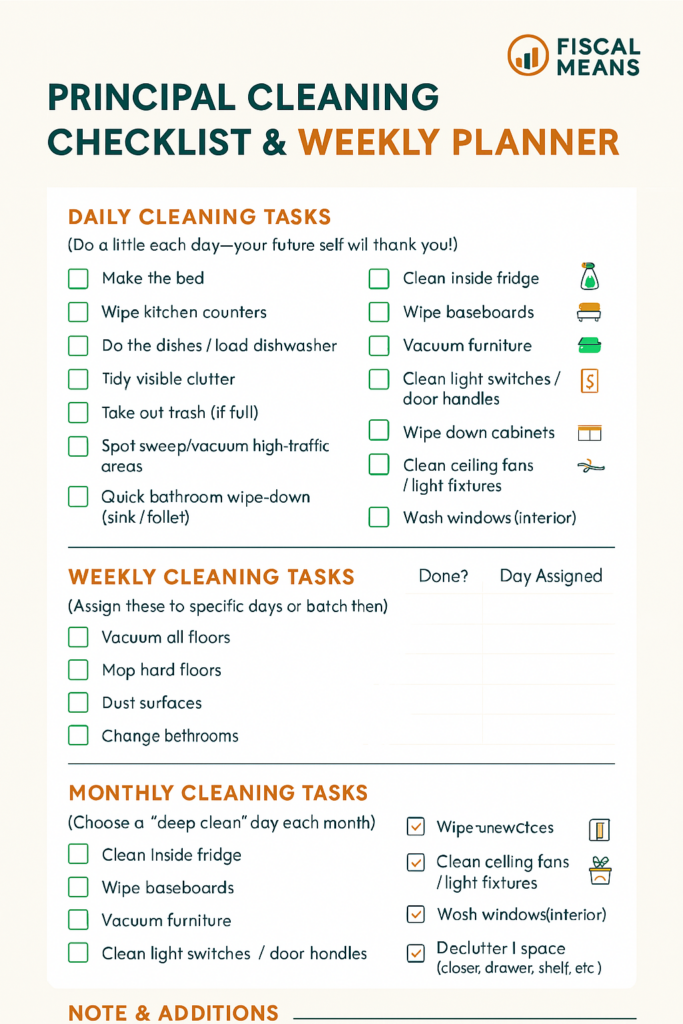
Let’s face it—cleaning isn’t exactly the thrill ride of adulthood. But neither is stepping on a rogue Lego, tripping over yesterday’s laundry pile, or wondering when your kitchen floor last saw a mop. If you’re tired of chaotic cleanups, passive-aggressive dust bunnies, and last-minute panic scrubs before guests arrive, it’s time to create a cleaning schedule that sticks.
And no, we don’t mean “stick” as in “you wrote it on a sticky note and forgot it exists.” We mean a routine that’s doable, flexible, and—dare we say—maybe even a little enjoyable.
Let’s break it down step-by-step so you can reclaim your space (and sanity).
Step 1: Embrace Your Reality (Not Pinterest’s)
Before you plan a cleaning schedule worthy of a royal palace, take a deep breath and consider your actual life.
- Do you work full-time?
- Have pets? Kids? A tendency to ignore your inbox until it becomes a federal disaster zone?
- Are you a night owl, early bird, or a perpetually exhausted pigeon?
Your cleaning schedule has to fit your lifestyle. There’s no gold star for scrubbing baseboards daily if it makes you resent everything about your home. Start small. Clean smart. And be honest about how much time and energy you realistically have.
Step 2: List Out All the Cleaning Tasks
Time to get everything out in the open. Literally. Write down every cleaning task you can think of—big or small. Here’s a jumpstart list:
Daily Tasks
- Make the bed
- Wipe kitchen counters
- Wash dishes/load dishwasher
- Tidy clutter
- Scoop the litter box/take out trash
Weekly Tasks
- Vacuum and mop floors
- Dust surfaces
- Clean bathrooms
- Change bed sheets
- Do laundry (unless you prefer Mount Washmore to become a permanent landmark)
Monthly Tasks
- Clean out fridge
- Wipe down baseboards
- Vacuum furniture
- Clean windows
- Wipe down light switches and door handles
Seasonal/Occasional Tasks
- Deep clean the oven
- Wash curtains
- Flip mattresses
- Declutter closets
- Organize garage or storage spaces
Don’t worry about feeling overwhelmed. This is the “data dump” stage. We’ll organize it in a minute.
Step 3: Categorize By Frequency and Priority
Once your cleaning to-do list looks like it belongs in an overachiever’s bullet journal, group tasks by how often they need doing. Be honest again. Some folks are fine vacuuming once a week; others need to bust out the Dyson every other day (especially if you live with pets or tiny humans).
Now, ask yourself:
- What must be done daily for you to feel sane?
- What can be done weekly without disrupting your life?
- What feels satisfying but not urgent—so you can tackle it monthly or seasonally?
The trick is to prioritize for peace, not perfection.
Step 4: Choose a Cleaning Schedule Format That Works for You
Now that you know what you need to clean and how often, let’s find your cleaning style. Think of this like dating: the format has to match your vibe or it’ll fizzle out in a week.
Here are a few common cleaning schedule approaches:
1. Room-by-Room Rotation
Each day focuses on a different area:
- Monday – Kitchen
- Tuesday – Bathrooms
- Wednesday – Bedrooms
- Thursday – Living areas
- Friday – Laundry + catch-up
- Saturday – Outdoor or garage
- Sunday – Rest (or optional deep clean)
This keeps things feeling balanced, especially if you like knowing exactly where to focus.
2. Task-Based Rotation
Rather than cleaning by room, you clean by task:
- Monday – Dusting
- Tuesday – Floors
- Wednesday – Bathrooms
- Thursday – Kitchen
- Friday – Laundry
- Saturday – Declutter/organize
This is great if you find it easier to stay in “vacuum mode” or “disinfect everything mode.”
3. Time-Block Cleaning
Got limited time? Set a timer. Clean what you can in a set block:
- 15 minutes in the morning
- 30 minutes on Saturdays
- A quick 5-minute tidy after dinner
This works like magic for busy people and perfectionists alike—it focuses on progress, not completion.
4. Hybrid Schedule
Combine all of the above! Maybe you deep-clean the bathroom every Sunday but wipe down the sink daily. Maybe you vacuum all the floors in one go, but only clean the windows every other month.
Make your plan as custom as your coffee order.
Step 5: Write It Down (Digitally or on Paper)
Schedules that stay in your head are more like suggestions. Let’s give this plan some visibility. Try one of the following:
- A printable weekly cleaning chart on your fridge
- A dry erase board in your kitchen or hallway
- A checklist in a planner or bullet journal
- A recurring reminder in your phone calendar
- An app like Tody, Sweepy, or Home Routines
Bonus points if you color-code or add satisfying checkboxes. Checkmarks are free dopamine.
Step 6: Make It a Habit, Not a Hassle
Here’s the not-so-secret sauce to making your cleaning schedule stick: consistency + grace.
Tips for Habit-Forming Cleanliness:
- Stack it with other habits. Wipe the counters while your coffee brews. Toss in laundry before your workout.
- Use music or podcasts. Cleaning with a vibe makes it feel like less of a chore.
- Set a timer and make it a challenge. “Can I clean the whole kitchen in 10 minutes? Let’s go.”
- Don’t restart after every missed day. Life happens. Just pick back up where you left off.
- Celebrate tiny wins. Cleaned your sink? Gold star. You’re doing great.
Step 7: Get Others Involved (If You Can)
Unless you live alone (and even then, Alexa can only do so much), cleaning should not be a solo sport. Assign age-appropriate chores to kids, split responsibilities with roommates or partners, and have a shared schedule where everyone sees what needs to be done.
Try:
- A family chore chart
- A points system for kids (clean bathroom = 5 points = screen time!)
- “Power hour” cleaning sessions with everyone tackling one room
Even pets can help… Okay, not really. But a Roomba counts, right?
Step 8: Build in Flex Days & Deep Clean Days
Don’t pack your cleaning schedule so tight that you can’t breathe. Just like your budget needs a little “fun money,” your schedule needs breathing room.
Designate:
- One “skip” day per week where you can opt out guilt-free
- One monthly deep clean day to knock out something bigger (cleaning the oven, purging the garage, etc.)
- One declutter day per season to donate, toss, or reorganize
Think of it like maintenance for your sanity. You’re not just cleaning your home—you’re managing your environment in a way that works for your mental health.
Bonus Tips: Keeping the Momentum Going
Here’s how to make your cleaning schedule stick long-term:
- Do a weekly reset. Spend 15–30 minutes Sunday night resetting your space for the week ahead.
- Keep supplies where you need them. Want to wipe the bathroom sink daily? Keep cleaner and a cloth nearby.
- Don’t overthink. Just start. A tidy home is built in small moments, not marathon scrub sessions.
- Reward yourself. Light a candle after cleaning. Make tea. Post a selfie in your fresh space. You earned it.
Final Thoughts: Progress Over Perfection
Your home doesn’t have to be spotless—it has to be livable and lovable. Creating a cleaning schedule that sticks isn’t about impressing anyone else; it’s about designing a system that works for you. One that keeps your space peaceful, your stress levels low, and your energy flowing toward things you actually enjoy.
So whether your cleaning style is “Monica Geller” or “I vacuumed because I dropped a chip,” your schedule can reflect what works in real life.
Now grab a notebook (or your Notes app), sketch out your cleaning goals, and remember: done is better than perfect. Your future self—stepping barefoot onto a crumb-free floor—will thank you.
R. A. Goldston, CPA at Large

 Previous post
Previous post
 Next post
Next post
